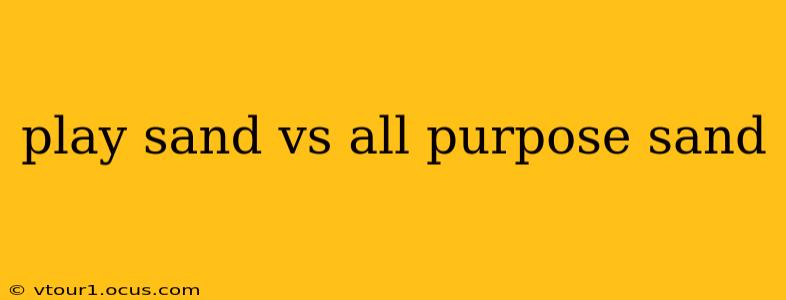Choosing the right sand can make all the difference, whether you're building a magnificent sandcastle on the beach or creating a sturdy concrete foundation. This article delves into the key differences between play sand and all-purpose sand, helping you make an informed decision based on your specific project. We'll explore their composition, uses, and potential drawbacks, answering common questions along the way.
What is Play Sand?
Play sand, also known as children's sand, is specifically designed for use in playgrounds and sandboxes. It's carefully cleaned and processed to remove sharp edges, rocks, and potentially harmful materials. This meticulous cleaning makes it safe for children to play with, reducing the risk of cuts or abrasions. Its fine texture also contributes to its playability, allowing for easy molding and shaping.
What is All-Purpose Sand?
All-purpose sand, as its name suggests, has a broader range of applications. It's often coarser than play sand and may contain a higher percentage of larger particles and even small stones. While unsuitable for children's play due to its potential for causing injury, its coarser texture and varied particle sizes make it ideal for various construction and landscaping projects.
What are the Key Differences Between Play Sand and All-Purpose Sand?
The primary differences lie in their:
- Particle Size and Texture: Play sand has a much finer, smoother texture compared to all-purpose sand, which is typically coarser and contains a wider range of particle sizes.
- Cleaning and Processing: Play sand undergoes rigorous cleaning and processing to remove impurities and sharp edges, ensuring its safety for children. All-purpose sand is less rigorously processed.
- Intended Use: Play sand is exclusively for children's play, while all-purpose sand has broader applications in construction, landscaping, and other projects.
- Cost: Generally, play sand is more expensive than all-purpose sand due to the extra processing involved.
Is Play Sand Safe for Concrete?
No, play sand is generally not recommended for concrete mixes. Its fine texture can lead to a weaker concrete mix compared to the coarser aggregates typically used in construction. The consistency and strength of concrete relies on a specific mix of cement, water, and aggregates of various sizes, and play sand doesn't provide the necessary structural integrity.
Can I Use All-Purpose Sand for a Sandbox?
No, using all-purpose sand in a sandbox is strongly discouraged. The presence of sharp edges, rocks, and potentially harmful materials poses a significant risk of injury to children. Always prioritize play sand for sandboxes to ensure a safe playing environment.
What Type of Sand is Best for Mortar?
Mortar typically requires a specific type of sand that's carefully graded for consistent particle size distribution and cleanliness. While all-purpose sand might be suitable in some cases, it's best to consult with a building materials supplier or a professional mason to determine the ideal sand type for your mortar mix, as the sand specifications can vary greatly depending on the project and the desired properties of the mortar.
What is the Best Sand for Backfilling?
The best sand for backfilling depends on the specific application. For some projects, all-purpose sand might suffice. However, for applications requiring high drainage capacity, a coarser, well-graded sand might be preferable. Again, consulting a professional for guidance based on your particular project is always a good practice.
Conclusion
Choosing between play sand and all-purpose sand depends entirely on your intended use. Play sand prioritizes safety and fine texture for children's play, while all-purpose sand offers a more cost-effective solution for various construction and landscaping needs. Always prioritize safety and choose the appropriate sand type to ensure your project is successful and safe for all involved. Remember to consult with professionals for large-scale or critical projects to guarantee the best results.
